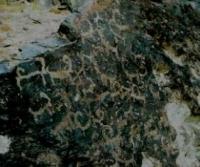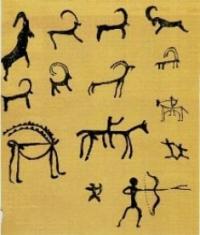You are here
Сave drawings of Tajikistan.



Central Asia on Silk Road Tour.
“He who conquers himself is the mightiest warrior”
Confucius.
Dushanbe and Central Asia on Great Silk Road.
Petroglyphs (carved rock drawings) represent a distinct group of ancient monuments. The Pamirs, with more than 50 sites, is the richest area for rock drawings in Tajikistan. They are found in the valleys of the Ghunt River (at the Chertym Dam), Panj (near Namatgut), Langar, Porshnev, Shohdara, Yazghulom, North Ak-Jilga villages and in the Bartang River estuary.
These are the main points of concentration of petroglyphs. They are divided into groups according to their approximate age. The earliest ones are dated from the bronze age, and the more recent ones are from the early medieval, developed medieval and modern periods.
The greatest number of known petroglyphs are found in the Langar and Kisht village area in Ishkashim district. The total number of the rock drawings has not been counted, but there may be more than 6,000. The drawings are carved on the surface of granite rocks.
They are combined into several "fields" connected by a chain of separate pictures. They are found in the area starting from the foothills of the Shohdara range and extend almost as far as the watershed. The petroglyphs are usually drawings of mountain goats, yaks, deer, riders, and hunters with bows and dogs.
Some drawings have been found at 3200 - 3300 m above sea level. The majority of the pictures were done using a "spot technique", i.e. engraved by a metal tool or a stone. In odd cases one can find deeply engraved pictures made with a metal object.
Sometimes pictures have been scratched using a sharp knife-edge.The pictures in Langar contain frequently repeated themes - scenes of hunting and of nakhchir (mountain goats). Most of these are drawings 10 - 20 cm long, with occasional ones 30 – 40 cm long.
The biggest figure is 80 cm, the smallest one 6cm. Also interesting are drawings of rubobs a favourite local musical instrument. It is remarkable that there have been no other discoveries in Central Asia of a comparable quantity of petroglyphs showing musical instruments (about 300).
A hypothesis, based on Pamiri folklore, is that a rubob represents a man, therefore the discovered pictures are actually stylized pictures of the people. Another region with interesting petroglyphs is Vy-bist-dara. It is located 7-8km higher than the Debasta village (30 km from Khorugh) at the end of a valley of the same name.
There are four groups of rocky manuscripts. The central one has the biggest concentration of petroglyphs. Unlike the majority of Pamiri petroglyphs, in which themes of hunting wild goats with bows and dogs dominate, pictures in the Vybist-dara are devoted to the portrayal of people and ornaments.
The oldest group of pictures comes from the second half of the I st century B.C. There are many petroglyphs on the 23 x 19 m black shale stone of the Ak-Jilga River valley (left side of the Bazar-dara River) in the East Pamirs, a few kilometres from the remains of the ancient mining town of Bazar-dara.
You can see pictures of mountain goats, an archer with a hooked nose and a pointed hat, and a two-wheeled chariot harnessed by horses and driven by coachmen. Pictures of chariots are well known in Central Asia and date from the bronze age.
It is difficult to say what the ancient people intended by their drawings. They may have had religious significance, or described their daily life. Perhaps it was just an expression of their imagination, or the desire to leave a permanent memento of themselves.
One thing is clear - the drawings reflect the centuries-old history of the people who lived in this area or came here from other places. Transportation - Khorugh-ishkashim regular bus and further by hitchhiking or taxi to Langar village, and then on foot.
A taxi from Khorugh up to Debasta village and further on foot. Ak-Jilga River area - only by private car and further on foot or by helicopter.
Authority and photos:
Gafurov.BG. «Tadjiks:The Most ancient, ancient and medieval history»., 1972. Djakonov M.M. « Works Kafirnighan of group»: “Antiquities of Tajikistan: the Exhibition catalogue. Dushanbe, 1985. Bolshakov O.G.







